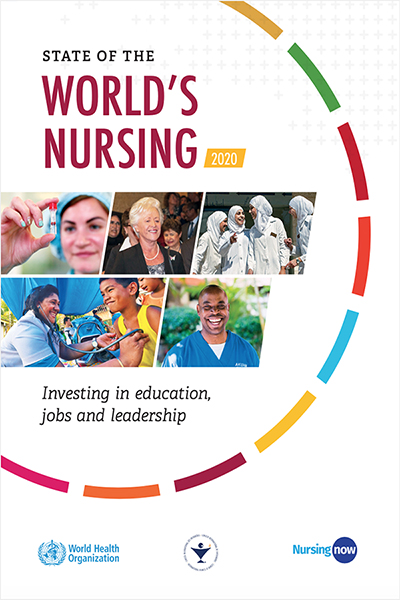WHO and partners call for urgent investment in nurses
April 07, 2020The Covid-19 pandemic underscores the urgent need to strengthen the global health workforce. A new report, The State of the World’s Nursing 2020, provides an in-depth look at the largest component of the health workforce. Findings identify important gaps in the nursing workforce and priority areas for investment in nursing education, jobs, and leadership to strengthen nursing around the world and improve health for all. Nurses account for more than half of all the world’s health workers, providing vital services throughout the health system. Historically, as well as today, nurses are at the forefront of fighting epidemics and pandemics that threaten health across the globe. Around the world they are demonstrating their compassion, bravery and courage as they respond to the COVID-19 pandemic: never before has their value been more clearly demonstrated.
‘Nurses are the backbone of any health system. Today, many nurses find themselves on the frontline in the battle against Covid-19,’ said Dr Tedros Adhanom Ghebreyesus, WHO Director General. ‘This report is a stark reminder of the unique role they play, and a wakeup call to ensure they get the support they need to keep the world healthy.’
 |
The report, by the World Health Organization (WHO) in partnership with the International Council of Nurses (ICN) and Nursing Now, reveals that today, there are just under 28 million nurses worldwide. Between 2013 and 2018, nursing numbers increased by 4.7 million. But this still leaves a global shortfall of 5.9 million - with the greatest gaps found in countries in Africa, South East Asia and the WHO Eastern Mediterranean region as well as some parts of Latin America.
Revealingly, more than 80 per cent of the world’s nurses work in countries that are home to half of the world’s population. And one in every eight nurses practices in a country other than the one where they were born or trained. Ageing also threatens the nursing workforce: one out of six of the world’s nurses are expected to retire in the next 10 years.
To avert the global shortage, the report estimates that countries experiencing shortages need to increase the total number of nurse graduates by on average 8% per year, along with improved ability to be employed and retained in the health system. This would cost roughly USD 10 per capita (population) per year.
“Politicians understand the cost of educating and maintaining a professional nursing workforce, but only now are many of them recognizing their true value,” said ICN President Annette Kennedy. “Every penny invested in nursing raises the wellbeing of people and families in tangible ways that are clear for everyone to see. This report highlights the nursing contribution and confirms that investment in the nursing profession is a benefit to society, not a cost. The world needs millions more nurses, and we are calling on governments to do the right thing, invest in this wonderful profession and watch their populations benefit from the amazing work that only nurses can do.”
About 90 per cent of all nurses are female, yet few nurses are found in senior health leadership positions-- the bulk of those positions are held by men. But when countries enable nurses to take a leadership role, for example by having a government chief nursing officer (or equivalent), and nursing leadership programmes, conditions for nurses improve.
“This report places much-needed data and evidence behind calls to strengthen nursing leadership, advance nursing practice, and educate the nursing workforce for the future,” said Lord Nigel Crisp, Co-Chair of Nursing Now. “The policy options reflect actions we believe all countries can take over the next ten years to ensure there are enough nurses in all countries, and that nurses use of the full extent of their education, training, and professional scope to enhance primary health care delivery and respond to health emergencies such as COVID-19. This must start with broad and intersectoral dialogue which positions the nursing evidence in the context of a country’s health system, health workforce, and health priorities.”
To equip the world with the nursing workforce it needs, WHO and its partners recommend that all countries:
- increase funding to educate and employ more nurses;
- strengthen capacity to collect, analyze and act on data about the health workforce;
- monitor nurse mobility and migration and manage it responsibly and ethically;
- educate and train nurses in the scientific, technological and sociological skills they need to drive progress in primary health care;
- establish leadership positions including a government chief nurse and support leadership development among young nurses;
- ensure that nurses in primary health care teams work to their full potential, for example in preventing and managing noncommunicable diseases;
- improve working conditions including through safe staffing levels, fair salaries, and respecting rights to occupational health and safety;
- implement gender-sensitive nursing workforce policies;
- modernize professional nursing regulation by harmonizing education and practice standards and using systems that can recognize and process nurses’ credentials globally; and
- strengthen the role of nurses in care teams by bringing different sectors (health, education, immigration, finance and labour) together with nursing stakeholders for policy dialogue and workforce planning.
The report’s message is clear: governments need to invest in a massive acceleration of nursing education, creation of nursing jobs, and leadership. Without nurses, midwives, and other health workers, countries cannot win the battle against outbreaks, or achieve universal health coverage and the Sustainable Development Goals.
Courtesy : who
